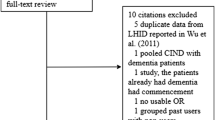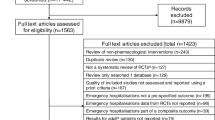Abstract
Purpose
To analyze the quality of research on the use of benzodiazepines (BZDs) in the emergency room by the elderly population through the Strengthening the Reporting of Observational Studies in Epidemiology (STROBE) initiative.
Methods
A systematic review was carried out according to the following steps: (1) identification of studies, in which studies were selected from different combinations of the descriptors “elderly–aged,” “benzodiazepines,” and “emergency room” in the EMBASE–MEDLINE, SciELO, Scopus, and Web of Science databases; (2) evaluation of studies, in which the title, abstract, and full text of the studies were assessed; (3) evaluation of the methodological quality of the studies. The criteria used were those included in the STROBE recommendations.
Results
At the end of the selection process, only six articles were identified which met the specific criteria. The sample sizes in these studies varied from 118 to 1,611 patients. More than half (4) of the studies did not describe the type of design used, whereas all collected demographic data and analyzed details on the use of BZDs, such as type administered and/or its relationship to the symptoms, were shown. No article fully complied with the STROBE criteria.
Conclusions
This review shows a lack of methodological quality in the studies performed to date that have evaluated the use of BZDs in elderly patients in emergency rooms. These findings should guide future research in this subject area, providing a more complete approach on aspects related to the use of medications by this specific population.

Similar content being viewed by others
References
World Health Organization (2006) Healthy ageing profiles. Guidance for producing local health profiles of older people: report of WHO consultation. World Health Organization, Geneva. Available at: http://www.euro.int/document/E91887.pdf. Accessed 2 Nov 2011
Chen YF, Dewey ME, Avery AJ (2001) The Analysis Group of the MRCCFA Study. Self-reported medication use for older people in England Wales. J Clin Pharm Ther 26:129–140
Sharkey JR, Browne B, Ory MG, Wang S (2005) Patterns of therapeutic medication category use among community-dwelling homebound older adults. Pharmacoepidemiol Drug Saf 14:715–723
Center for Behavioral Health Statistics and Quality (2011) Substance Abuse and Mental Health Services Administration. Drug Abuse Warning Network, 2008: national estimates of drug-Related emergency department visits. U.S. Department of Health and Human Services (HHS) publication no. (SMA) 11–4618. HHS, Rockville
Banerjee A, Mbamalu D, Ebrahimi S et al (2011) The prevalence of polypharmacy in elderly attenders to an emergency department—a problem with a need for an effective solution. Int J Emerg Med 4:22
Gurwitz JH, Field TS, Harrold LR et al (2003) Incidence and prevalence of adverse drug events among older persons in the ambulatory setting. JAMA 289:1107–1116
Beers MH, Ouslander JG, Rollingher I et al (1991) Explicit criteria for determining inappropriate medication use in nursing home residents. Arch Intern Med 151:1825–1832
Gallagher PF, Barry PJ, Ryan C et al (2008) Inappropriate prescribing in an acutely ill population of elderly patients as determined by Beers’ Criteria. Age Ageing 37:96–101
Fick DM, Cooper JW, Wade WE et al (2003) Updating the Beers criteria for potentially inappropriate medication use in older adults: results of a US consensus panel of experts. Arch Intern Med 163:2716–2724
Higgins K, Cooper-Stanbury M, Williams (2000) Statistics on drug use in Australia in 1998. Australian Institute of Health and Welfare, Canberra
Neutel CI (2005) The epidemiology of long-term benzodiazepine use. Int Rev Psychiatry 17:189–197
Fritsch MR, Rojas CG, Gaete OJ et al (2005) Benzodiazepine use in Santiago, Chile. Actas Esp Psiquiatr 33:286–291
Ciuna A, Andretta M, Corbari L (2004) Are we going to increase the use of antidepressants up to that of benzodiazepines? Eur J Clin Pharmacol 60:629–634
Vedia UC, Bonet M, Forcada V et al (2005) Estudio de utilización de psicofármacos en atención primaria. Aten Primaria 36:239–245
Groenwold RH, Van Deursen AM, Hoes AW et al (2008) Poor quality of reporting confounding bias in observational intervention studies: a systematic review. Ann Epidemiol 18:746–751
Von Elm E, Altman DG, Egger M (2007) Strengthening the Reporting of Observational Studies in Epidemiology (STROBE) statement: guidelines for reporting observational studies. Br Med J 335:806–808
Hosmer DW, Lameshow S (1989) Applied logistic regression. Wiley, New York
Moher D, Liberati A, Tetzlaff J et al (2008) The PRISMA group preferred reporting items for systematic reviews and meta-analyses: thePRISMA statement. PLoS Med 6:e1000097. doi:10.1371/journal.pmed.1000097
Spanemberg L, Nogueira EL, Silva CTB et al (2011) High prevalence and prescription of benzodiazepines for elderly: data from psychiatric consultation to patients from an emergency room of a general hospital. Gen Hosp Psychiatry 33:45–50
Kurtzthaler I, Wambacher M, Golser K et al (2005) Alcohol and/or benzodiazepine use: different accidents–different impacts? Hum Psychopharmacol 20:583–589
Heininger-Rothbucher D, Daxecker M, Ulmer H et al (2003) Problematic drugs in elderly patients presenting to a European emergency room. Eur J Intern Med 14:372–376
Pierfitte C, Macouillard G, Thicoipe M et al (2001) Benzodiazepines and hip fractures in elderly people: case–control study. Br Med J 322:704–708
Verhaeghe W, Mets T, Corne L (1996) Benzodiazepines use among elederly patients presenting at the emergency room. Arch Gerontol Geriatr 22:55–62
Puryear DA, Lovitt R, Miller DA (1991) Characteristics of elderly persons seen in a urban psychiatric emergency room. Hosp Community Psychiatry 42:802–807
Cascadee KAH, Kwentus JA et al (2009) Trends in CNS prescribing following the economic slowdown. Psychiatry (Edgmont) 6:15–17
Ravera S, Hummel SA, Stolk P et al (2009) The use of driving impairing medicines: a European survey. Eur J Clin Pharmacol 69:1139–1147
Furtado C, Teixeira I (2006) Utilização de benzodiazepinas em Portugal continental (1999–2003). Acta Med Port 19:239–246
International Narcotics Control Board (INCB) (2010) Report of the International Narcotics Control Board for 2009. INCB, Vienna
Touchette DR, Shapiro NL (2008) Medication compliance, adherence and persistence: current status of behavioral and educational interventions to improve outcomes. J Manag Care Pharm 14:S2–S10
Allen MH, Currrier GW (2004) Use of restraints and pharmacotherapy in academic psychiatric emergency services. Gen Hosp Psychiatry 26:42–49
Sweetman SC (2005) Martindale: the complete drug reference. Pharmaceutical Press, London
Sampol G, Rodes G, Rios J (2010) Acute hypercapnic respiratory failure in patients with sleep apneas. Arch Bronconeumol 46:466–472
Schneider DL (2002) Insomnia. Safe and effective therapy for sleep problems in the older patient. Geriatrics 57:24–32
Helbrook A, Crowther R, Lotter A (2001) The role of benzodiazepines in the treatment of insomnia: Meta-analysis of benzodiazepine use in the treatment of insomnia. J Am Geriatr Soc 49:824–826
Woolcott JC, Richardson KJ, Wiens MD et al (2009) Meta analysis of the impact of 9 medication classes on falls in elderly persons. Arch Inter Med 169:1952–1960
Hartikainen S, Lönnroos E (2010) Systematic review: use of sedatives and hypnotics, antidepressants and benzodiazepines in older people significantly increases their risk of falls. Evid Based Med 15:59. doi:10.1136/ebm1058
Young AS, Sullivan G, Burnam MA et al (1998) Measuring the quality of outpatient treatment for schizophrenia. Arch Gen Psychiatry 55:611–617
Lilford R, Mohammed M, Spiegelhalter D et al (2004) Use and misuse of process and outcome data in managing performance of acute medical care: avoiding institutional stigma. Lancet 363:1147–1154
Murff HJ, Patel VL, Hripcsak G et al (2003) Detecting adverse events for patient safety research: a review of current methodologies. JAMA 36:131–143
Sayer GP, McGeechan K, Kemp A et al (2003) The general practice research network: the capabilities of an electronic patient management system for longitudinal patient data. Pharmacoepidemiol Drug Saf 12:483–489
Wang SJ, Middleton B, Prosser LA et al (2003) A cost–benefit analysis of electronic medical records in primary care. Am J Med 114:397–403
Bates DW, Teich JM, Lee J et al (1999) The impact of computerized physician order entry on medication error prevention. J Am Med Inform Assoc 64:313–321
Jüni P, Altman DG, Egger M (2001) Systematic reviews in health care: assessing the quality of controlled clinical trials. Br Med J 323:42–46
Egger M, Schneider M, Davey Smith G (1998) Spurious precision? Meta-analysis of observational studies. Br Med J 316:140–144
Mellingsaeter TC, Bramness JG, Slørdal L (2006) Are z-hypnotics better and safer sleeping pills than benzodiazepines? Tidsskr Nor Laegeforen 126:2954–2956
Hausken AM, Furu K, Skurtveit S, Engeland A, Bramness JG (2009) Starting insomnia treatment: the use of benzodiazepines versus z-hypnotics. A prescription database study of predictors. Eur J Clin Pharmacol 65:295–301
Acknowledgments
This study was supported by the Coordenação de Aperfeiçoamento de Pessoal de Nível Superior (Capes).
Conflicts of interest
None.
Author information
Authors and Affiliations
Rights and permissions
About this article
Cite this article
Couto, A.T.R., Silva, D.T., Silvestre, C.C. et al. Quality analysis of research on the use of benzodiazepines by elderly patients in the emergency room:a systematic review. Eur J Clin Pharmacol 69, 1343–1350 (2013). https://doi.org/10.1007/s00228-012-1439-7
Received:
Accepted:
Published:
Issue Date:
DOI: https://doi.org/10.1007/s00228-012-1439-7




